Stability Now!
If the bottom of your snatch is full of trepidation and shaking, Bill Starr has the cure.
Originally published April 2015 in the CrossFit Journal.
I believe full snatches are the epitome of athleticism. If coaches in every sport—from wrestling to soccer to lacrosse to basketball—would insist that their athletes learn how to do this dynamic Olympic lift, athletic skills would be enhanced much more so than by going through plyometrics drills, pulling ropes and sleds, and employing other gimmicks designed to improve foot speed, agility and jumping ability. What those unusual exercises really do is line the pockets of the equipment providers. All the athletic attributes the coaches want their players to work on can be improved simply by doing snatches.
When done correctly, the full snatch is a flawless symphony of strength, quickness, timing, coordination and balance. Consider this: The athlete must pull a weighted bar as high as he possibly can in an explosive fashion, then shift his mental keys in a nanosecond to erupting downward and planting his feet solidly and perfectly so that he is able to control the bar with his arms locked securely over his head.
There are many things that have to be done before an athlete is able to master the technique in the full snatch, and that applies to both the split and squat style. He has to spend time making every part of his body a great deal stronger—from his ankles to his traps and wrists—to be able to elevate a heavy bar to a height that allows him to get under it and lock it out.
He must hone his timing to know the precise moment to make his move to the bottom. And he must do hundreds of reps in order to become stable enough to land on the platform in the exact same position every single time. In the bottom, his entire body must be extremely tight, with his torso erect as he fixes the bar over his head with elbows locked.
Finally, he has to be strong enough to recover from that bottom position. If he is unable to do that, then all previous efforts have been for naught. The snatch is not complete until the lifter stands up and controls the weight over his head.
So that’s the topic of this article: how to make the bottom position so strong that the lifter can still control the weight even when it’s not in the ideal spot overhead. We want lifters who are so strong that they can still stand up without difficulty even when they have to stay in the bottom for an extra long time as they adjust the bar to bring it into the proper alignment.
KISS: Keep It Simple, Squatter
The first exercise I use to enhance strength in the bottom of a snatch is the overhead squat. Overhead squats are extremely useful for any strength athlete because they work so many muscles in a very different manner. Squatting with weights overhead forces the shoulder girdle, back, hips and legs to contract in a unique way. Front and back squats only involve the shoulder girdle slightly, while overhead squats bring the arms and shoulders to the forefront.
Initially, I have the lifter power-snatch a weight, then do 5 overhead squats. After he gets the form down, I start piling on the plates. For the squats to be effective, heavy poundage must be handled—50 or 75 lb. more than what the lifter can snatch.
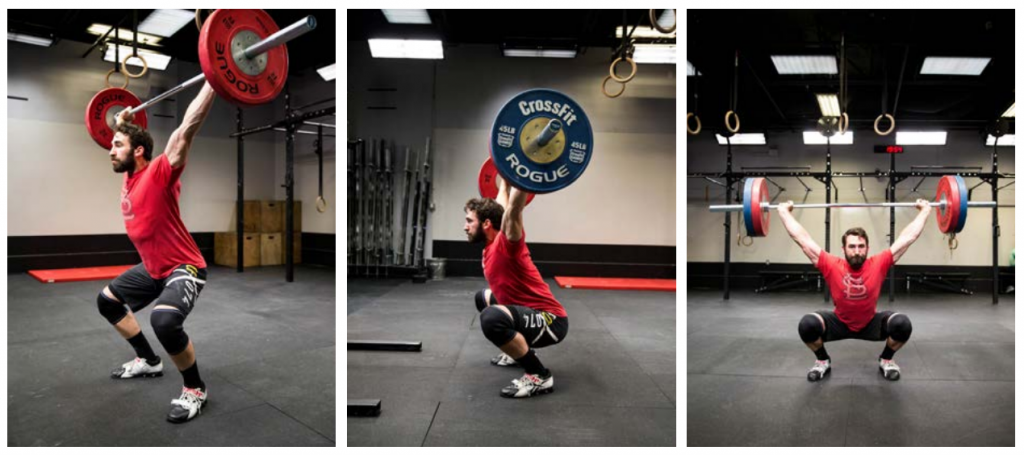
Regularly squatting 50-75 lb. more than you can snatch will increase stability and confidence when you go back to the quick lift.
This is where it gets a bit tricky. How is the lifter going to be able to get that much weight overhead? If there happens to be a very wide power rack available, that will solve the problem. Unfortunately, this type of rack is rare.
The solution to the problem is the same one we used in the ’50s, before any commercial power racks appeared on the market. I learned what to do from Sid Henry at the Downtown Dallas YMCA while I was attending Southern Methodist University in Texas. I really didn’t bother doing any overhead squats except as warm-ups for my snatch sessions. I didn’t need them because I wasn’t snatching that much weight. But after Henry began coaching me, my snatch improved considerably, and I got to the point where I did need to strengthen my bottom position.
However, the main reason several of us started doing the exercise was because Henry needed to do them to stay competitive with his two main rivals, Norbert Schemansky and Dick Kirk. They controlled the heavyweight division in the early ’60s.
There was nothing fancy about the Dallas Y weight room. It was primitive at best. Located on the sixth floor in a small room above the squash court, the space was originally designed to allow people to watch the squash games. There was room for a small platform and an area set aside for squatting, and we had enough space left over for lifters to sit between sets.
In order to do overhead squats, three lifters were needed: the one actually doing the exercise, plus two handlers/spotters. Gerald Travis, one of the top 198ers in Texas, and I were recruited. It went like this: We loaded an Olympic bar on the platform, and the designated lifter would then power-snatch the weight with assistance from his teammates to elevate it high enough for him to lock it out overhead. The lifter would do his set and the spotters would help him lower the bar back to the platform. This was before bumper plates came along, and none of us ever let a bar crash to the floor intentionally. The wooden floor was not made for that kind of stress, and if too many attempts fell hard, we would soon be out of a place to train.
This system worked well for Travis and me but not so well for Henry. He was 6 foot 3, and once he started handling heavy weights, it was a struggle for the two of us to lift the ends of the bar high enough for him to get under it. Henry was snatching 325 and wanted to overload by 50 or 75 lb., but there was no way this was going to happen.
Also, when Travis and I got to where we could handle 275 for reps, we both found that it was very difficult to lower the bar through the middle range. It always tended to run forward, and we had to concentrate on keeping our upper bodies very, very straight. In addition, because I was a splitter, I had to take some time to re-position my feet after the bar was locked out over my head. Henry and Travis used the squat style, so it was easier for them to get set before going into a full squat.
“We would sit in the bottom for six to eight seconds, moving our hips around, shifting back and forth slightly, and sometimes twisting just a tad.”
We always made sure the collars were tight before each set. If a bar did run out of control, we certainly didn’t want plates flying around the room.
After several weeks of doing these, Henry added a twist. We would sit in the bottom for six to eight seconds, moving our hips around, shifting back and forth slightly, and sometimes twisting just a tad. We were trying to duplicate what might happen during the execution of a full snatch. Then we would stand up. I believe this actually did more to improve my stability than the overhead squats.
Henry, a civil engineer, eventually figured out how to overload the overhead squats by a considerable amount. He went to a hardware store and bought some sturdy chains and attached hooks to them. He also got some clamps to shorten the chains. He rigged the chains to an iron beam above the platform. This worked really well. A bar could be set on the hooks just inside the collars, which made it much easier for us to load and unload the weights.
Henry decided we would start the overhead squats from the bottom. This made getting into position much easier as well. Once we were set, we simply lifted the bar off the hooks and stood up with the weight. We did the rest of our reps and—with the aid of the training partners—fixed the bar back in the hooks. We still spotted each other closely, and I have to admit that I got extremely nervous holding my hands under the moving bar when Henry was squatting with close to 400 lb.
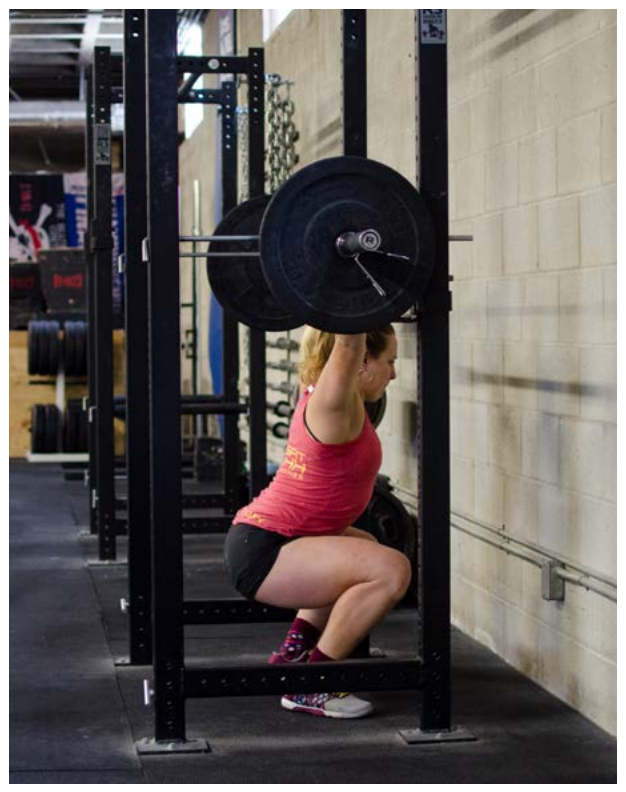
Locking into a 12-second isometric contraction requires a great deal of effort, but it will pay off when you’re fighting to stand up with a PR snatch.
The squats helped all three of us, but Henry got better results than Travis and I did. We never pushed them as hard as he did, and his hard work indeed paid off. In 1961, he was selected as a member of the U.S. team for the Tour of Russia, and he lifted in four venues in five days. At the contest in Tbilisi, he won gold. At the World Championships in Vienna, he came fifth. In 1963, he defeated the great Schemansky to win the senior national title, then won the Pan American Games and moved up a notch to fourth place at the Worlds in Stockholm.
Searching for More Stability
I left Dallas after I graduated from SMU and moved to Chicago, Illinois, to attend graduate school at George Williams College. I worked full time at the Park Ridge YMCA, and one of the first things I did was have our resident custodian build a platform and power rack for the weight room. I made sure the uprights were wide enough for me to be able to grip the bar for overhead squats.
After a year in the Windy City, I took a better-paying job at a YMCA in Marion, Indiana. With no handyman available, I built a power rack. It was ugly but functional, and once again I was able to use it for overhead squats as well as isometric contractions.
“Isos” rank high on my list of exercises to do to strengthen the bottom of the snatch. This was when isometrics were all the rage, and I had read everything on the subject. I did what the inventor, Dr. John Ziegler, recommended, and I used the same methods as Bill March and Louis Riecke. Both of those lifters had increased their totals by an astounding 100 lb. in less than one year. Later, we all found out they were also using anabolic steroids, but even without them, I got stronger from using isometrics. The isometrics were actually an isotonic movement in which you moved but a few inches before locking into an isometric contraction for 12 seconds.
(For more info on isometrics and isotonics, see the CrossFit Journal article “Short and Simple—and Effective.”)
I would do a few sets of overhead squats as warm-ups, then perform isometric work in two or three positions in the power rack, with most of the emphasis on the start. If I could move out of the deep bottom of the split with power, I never had any trouble finishing the lift. But I would still do an iso a couple of feet from the bottom and at the mid-point of the recovery for good measure.
I also used a variation to improve stability in the bottom. I would set the bar on top of the pins, get into a deep split, then move the weight off the pins and hold it off them for as long as I could. I found this to be very beneficial because I was forced to control the weight. It was never allowed to touch the uprights. It had to be held in the middle of the uprights so all work was done by the muscles and attachments.
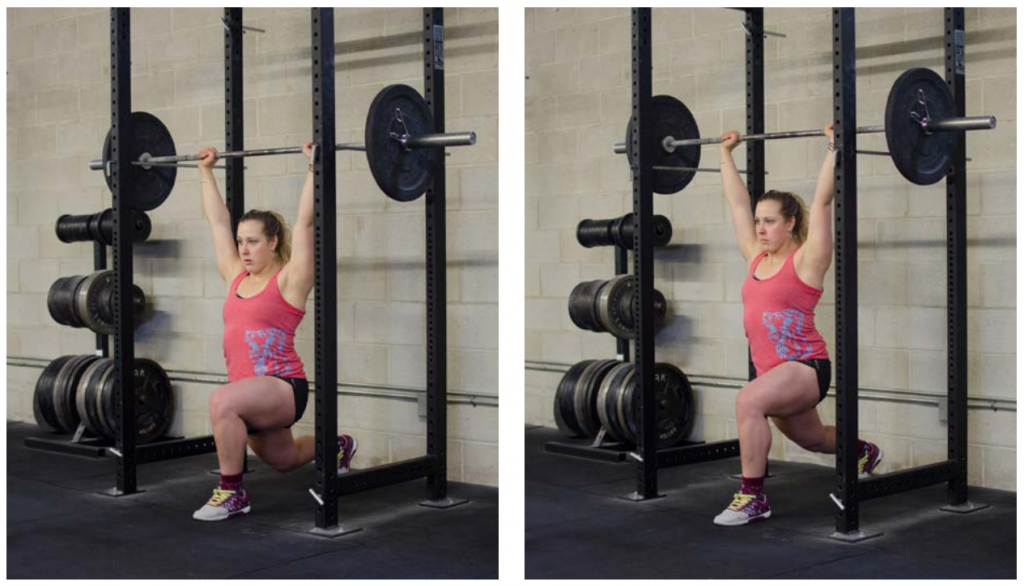
Starr used this isometric variation to help him recover from split snatches. After positioning himself properly, he’d raise the bar off the guards a few inches and then hold that position as long as he could.
All these exercises helped, and I was always able to stand up if I had locked the bar out over my head in the snatch. When I left Marion to move to York, I was snatching 245, and I knew I was going to have to do more to strengthen that bottom position if I wanted to move to the next level in the ranking lists. I continued to do isotonic-isometric contractions and hold the loaded bar off the top pins in the power rack, but I was looking for something different, something more dynamic.
I found it at the Eastern States competition, held in March 1965 in Schenectady, New York. I had only been at York Barbell for a month and was learning the ropes as assistant editor of Strength & Health. I covered the contest for the magazine and also assisted Tommy Suggs, who had hired me for the job.
There was a lot of talent present for the prestigious event that awarded the largest trophies of any meet in the country, including the seniors Tony Garcy, Bob Bartholomew and Phil Grippaldi, as well as rapidly rising star Bob Bednarski. Suggs was making his comeback after laying off for the better part of a year because of his knees. But the majority of the crowd that assembled in upstate New York that day came to see the confrontation between Garcy, national champion and Olympian, and the young phenom from Canada, Pierre St. Jean. At the Philly Open in January, they both totaled 915, but Garcy came through with a clutch clean and jerk to tie St. Jean and win by virtue of being the lighter man. However, there would be no battle because St. Jean had moved up to the light-heavyweight division, while Garcy was still a middleweight.
St. Jean put on a show. Weighing just 170, he pressed 290, snatched 295 and clean-and-jerked 370. He just missed a 305 snatch. His 955 total would have placed him fourth at the U.S. Senior Nationals. He was well on his way to becoming not only the best Canadian lifter since Doug Hepburn but also one of the best in the world. Only Bednarski, a heavyweight, out-snatched St. Jean.
After the light heavies finished, I wandered backstage, talking to lifters and trying to pick up tidbits of news to use in the magazine. As I walked past, I heard a lifter talking to St. Jean’s father and coach, Lionel. I stopped and listened as Lionel explained his son’s stability in the bottom of the snatch: “He should be solid. He’s handling 350 in the drop snatch.”
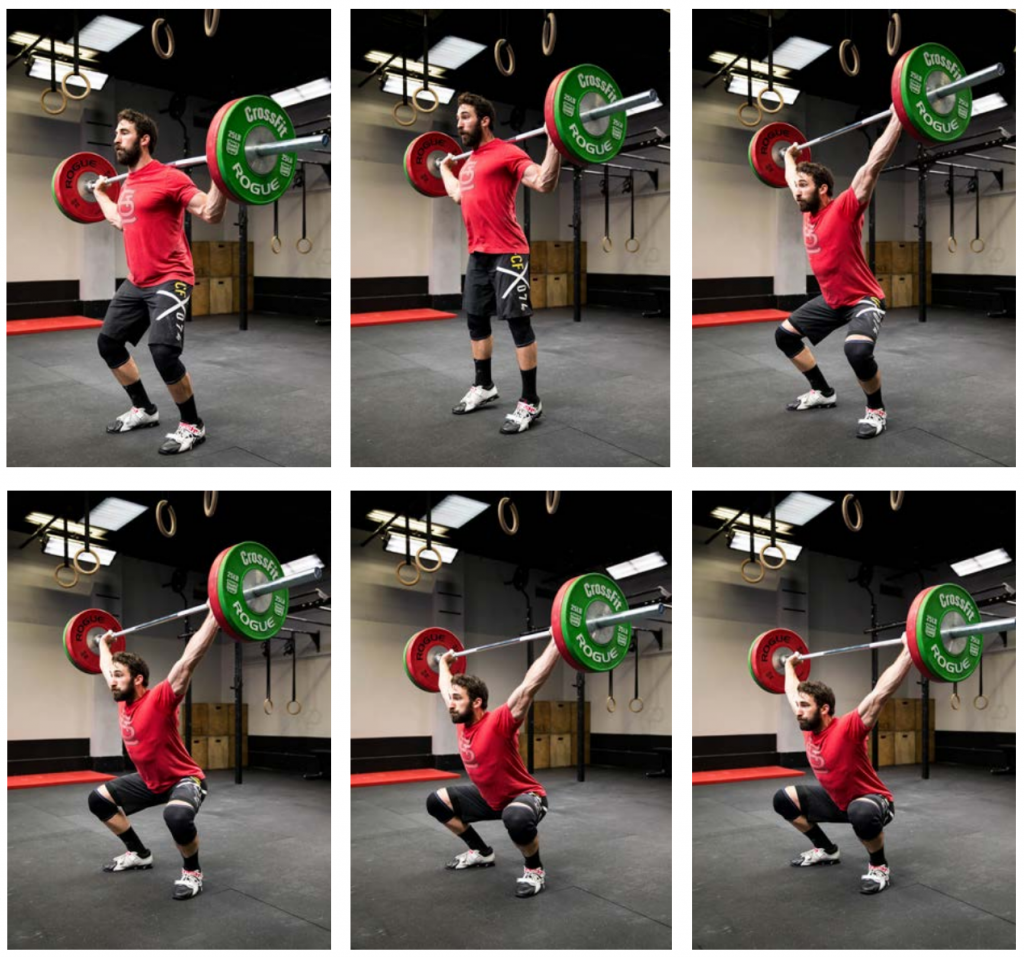
The “drop snatch” is now known as a “snatch balance.” The movement requires precision, speed, courage and determination.
Editor’s note: Starr’s description of the “drop snatch” more closely resembles the snatch balance with a dip, taught in the CrossFit Weightlifting Trainer Course. This exercise was at one time commonly referred to as the “drop snatch.”
I was dumbfounded. It didn’t seem possible. That meant St. Jean was able to do a drop snatch with more than double his body weight. Yet there was no reason for Lionel to lie. I had done drop snatches, but only in warm-up or as a quickness drill. I had never even considered using them as a primary exercise. But now I would. It was a revelation.
On the following Monday, none of the regulars trained in the York gym because they had lifted in the meet. So I had the gym all to myself, which is what I wanted. If I was going to stumble around like a cow on ice skates trying to do drop snatches with heavy weights, I didn’t want anyone to see me. I could have taken the bar off the power rack, but I wanted to have plenty of room just in case I had to dump the weights. I set two portable squat stands in the middle of the lifting platform and went to work.
“I was dumbfounded. It didn’t seem possible. That meant St. Jean was able to do a drop snatch with more than double his body weight.”
Since I had never handled more than 135 on the lift, I stayed with that weight for several sets to get the feel of the movement. Then I started adding weight and only doing 2 or 3 reps per set. By the time I got to 225, I felt comfortable doing the drop snatches and called it a day. I knew I could do them and would start moving the numbers up every time I included them in my workouts.
Here are the main form points: Using a wide or snatch grip, fix the bar firmly on your traps in much the same manner as you do when doing a back squat. The main difference is the position of your elbows. They need to be directly under the bar and not turned backward. You need to look straight ahead and continue to do so when you drive into the bottom. And you must keep your upper body very upright as you punch the bar off your traps and explode to the bottom. If you lean backward or forward, the bar will run too far out of the proper line for you to control it.
Set your feet at shoulder width and take a moment to make sure every muscle in your body is extremely tight, then bend your knees slightly and punch the bar in a straight line upward. The bar doesn’t have to travel very far—only 3 to 4 inches—but it has to be moving fast. As soon as you drive the bar off your traps, move to the bottom position in the snatch. Slam your feet into the platform. As you’re descending, exert pressure up against the bar. Do not allow it to float free. And don’t just hold the bar at arms’ length; push up against it and try to stretch the bar apart.
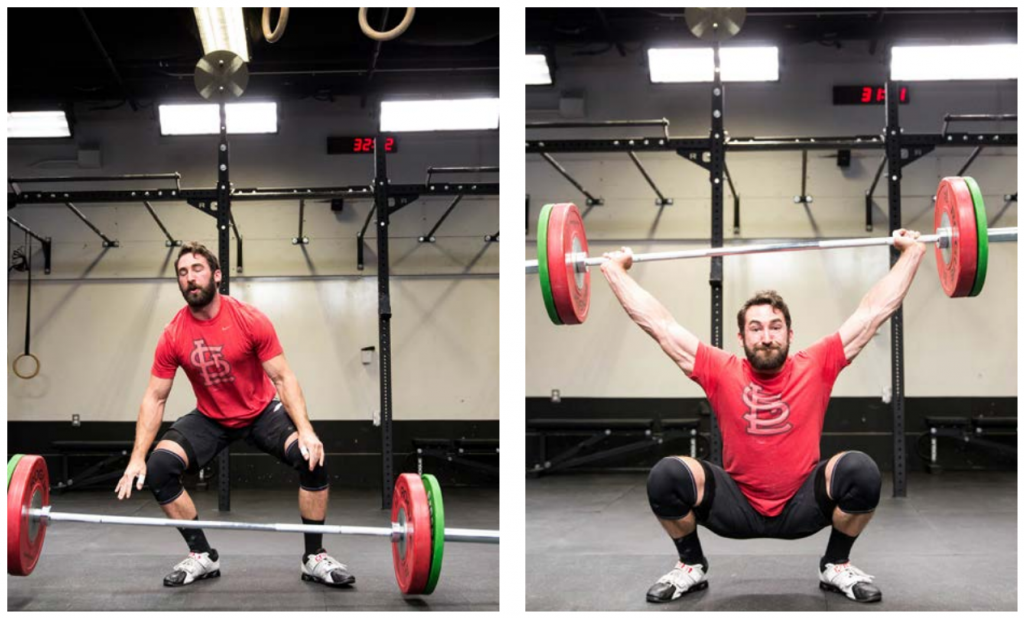
Success in the snatch comes down to fractions of inches when the weight is heavy. Some loads need to be dumped, but others can be saved if the lifter has a surplus of strength and a lot of determination.
This will enable you to be more solid when you hit the bottom, and if you have slammed your feet into the platform, the bar will just be where it should be: on an imaginary line directly up from the back of your head. Remain in the bottom position for four, five or six seconds before you stand up. Make slight adjustments in your shoulders, back and hips until you find the ideal rock-solid position.
Recover, and while bending your knees to help absorb the shock, lower the bar down to your traps. Reset your feet so they’re on a line, shoulder-width apart, and do another rep. When you’re only doing singles, put the bar back on the squat stand or rack and rest a bit before attempting another single.
Being able to hit the bottom exactly every rep takes time. The process cannot be hurried. I have my athletes place their feet where they want them to be in the bottom and then draw around their shoes with a piece of chalk. After going to the bottom in a drop snatch, they can see if they hit those marks. If they’re off a few inches, they can make adjustments.
When you recover, keep your eyes straight ahead or look up a bit. Don’t look down. That will cause the bar to run forward, and you’ll have difficulty completing the lift. When you start handling heavy poundage, as in more than you can full snatch, the drive off your traps has to be dynamic and intense. It doesn’t have to be a long punch, but it must be powerful, and you must react faster and faster as the weights get heavier.
Because there is so much balance, coordination, timing and foot speed involved in the drop snatch, using a considerable amount of weight has great carry-over value for the full snatch, the full clean and the jerk, but also for any athletic endeavor.
There is one attribute a lifter must have in order to do a drop snatch more than 50 lb. above his best snatch: intestinal fortitude. It takes courage, resoluteness and plain-old guts to drive down under a heavy weight that is right over your body. But if a lifter hesitates and only goes down halfway, the exercise is useless. And I have observed that those lifters who shied away from going into the deep bottom position never went low when they did full snatches.
“No guts, no glory” is the perfect expression regarding drop snatches.
When I added drop snatches to my program, I wasn’t sure how much weight I would have to use to ensure I would always be secure in the bottom of my split snatches. But knowing the lightweight St. Jean used 350 and I was a 198-pounder, I set my goal at 360 to better what the Canadian had done. I don’t recall exactly how long it took me, but I think it was about a year before I did a deep drop snatch with 360. After that, I only did them every so often because I needed to spend more time on the parts of the three lifts that were weaker.
All the exercises I mentioned in this piece—overhead squats, isotonic-isometric contractions with the bar locked over my head and especially drop snatches—enabled me to establish a solid bottom position in the snatch. It gave me a huge boost of confidence to know that if I pulled a weight high enough and got under it, I could finish the lift.
If you think you need to make your bottom position stronger, start doing all these exercises. If you decide to only do one of them, make sure it’s drop snatches. They build strength, and they build character.
About the Author:
Bill Starr coached at the 1968 Olympics in Mexico City, the 1970 Olympic Weightlifting World Championship in Columbus, Ohio, and the 1975 World Powerlifting Championships in Birmingham, England. He was selected as head coach of the 1969 team that competed in the Tournament of Americas in Mayaguez, Puerto Rico, where the United States won the team title, making him the first active lifter to be head coach of an international Olympic weightlifting team. Starr is the author of the books The Strongest Shall Survive: Strength Training for Football and Defying Gravity, which can be found at The Aasgaard Company Bookstore. Bill Starr passed in 2015 at the age of 77.
All images: Dave Re / CrossFit Journal
Stability Now!